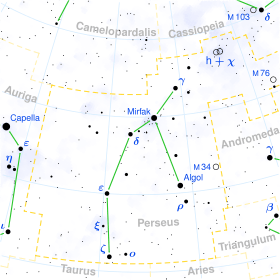1 Persei
1 Persei (1 Per) is an eclipsing binary[3] star in the constellation Perseus. Its uneclipsed apparent magnitude is 5.49. The binary star consists of two B2 type main-sequence stars in a 25.9 day eccentric orbit.[5] The stars are surrounded by a faint cloud of gas visible in mid-infrared, although whether they are the origin of the gas or simply passing through it is unclear.
 | |
| Observation data Epoch J2000.0 Equinox J2000.0 | |
|---|---|
| Constellation | Perseus |
| Right ascension | 01h 51m 59.320s[1] |
| Declination | +55° 08′ 50.58″[1] |
| Apparent magnitude (V) | 5.49 - 5.74 - 5.85[2] |
| Characteristics | |
| Spectral type | B1.5V[2] |
| Variable type | eclipsing binary[3] |
| Astrometry | |
| Proper motion (μ) | RA: 12.05 ± 0.25[1] mas/yr Dec.: −9.18 ± 0.28[1] mas/yr |
| Parallax (π) | 2.52 ± 0.33[1] mas |
| Distance | approx. 1,300 ly (approx. 400 pc) |
| Absolute magnitude (MV) | −1.37/−1.77[4] |
| Orbit[4] | |
| Primary | 1 Persei A |
| Companion | 1 Persei B |
| Period (P) | 25.935951±0.000003 d |
| Eccentricity (e) | 0.3768±0.0014 |
| Inclination (i) | 88.048±0.002° |
| Periastron epoch (T) | 2443563.466±0.005 HJD |
| Argument of periastron (ω) (secondary) | 109.83±0.10° |
| Semi-amplitude (K1) (primary) | 97.4±0.1 km/s |
| Semi-amplitude (K2) (secondary) | 91.2±0.1 km/s |
| Details[4] | |
| Primary | |
| Mass | 6.95 M☉ |
| Radius | 3.29 R☉ |
| Luminosity | 2,188 L☉ |
| Surface gravity (log g) | 4.25 cgs |
| Temperature | 21,500 K |
| Rotation | 1.45 days |
| Rotational velocity (v sin i) | 115 km/s |
| Secondary | |
| Mass | 7.42 M☉ |
| Radius | 3.86 R☉ |
| Luminosity | 3,311 L☉ |
| Surface gravity (log g) | 4.14 cgs |
| Temperature | 22,000 K |
| Rotation | 1.40 days |
| Rotational velocity (v sin i) | 140 km/s |
| Other designations | |
| Database references | |
| SIMBAD | data |
Observational history
The possible eclipsing binary nature of 1 Persei was first noticed by Donald Kurtz in 1977 when it was used as a comparison star to test for photometric variability of HD 11408.[6] In 1979 French amateur observers succeeded in determining an orbital period of 25.9 days.[7] During the primary eclipse, the brightness drops to magnitude 5.85. In the secondary eclipses, the brightness drops to magnitude 5.74. The eclipses each last for approximately 25 hours.[2]
References
- van Leeuwen, F. (2007). "Validation of the new Hipparcos reduction". Astronomy and Astrophysics. 474 (2): 653–664. arXiv:0708.1752. Bibcode:2007A&A...474..653V. doi:10.1051/0004-6361:20078357.Vizier catalog entry
- Samus, N. N.; Durlevich, O. V.; et al. (2009). "VizieR Online Data Catalog: General Catalogue of Variable Stars (Samus+ 2007-2013)". VizieR On-line Data Catalog: B/gcvs. Originally Published in: 2009yCat....102025S. 1. Bibcode:2009yCat....102025S.
- North, P.; et al. (1981). "1 Per: a new eclipsing binary with a long period and an elliptical orbit". Information Bulletin on Variable Stars. 2036. Bibcode:1981IBVS.2036....1N.
- Janík, J.; et al. (2003). "Search for forced oscillations in binaries. IV. The eclipsing binary V436 Per revisited". Astronomy and Astrophysics. 408 (2): 611–619. Bibcode:2003A&A...408..611J. doi:10.1051/0004-6361:20030960.
- Harmanec, P.; et al. (1997). "Search for forced oscillations in binaries. I. The eclipsing and spectroscopic binary V436 Persei = 1 Persei". Astronomy and Astrophysics. 319 (2): 867–880. Bibcode:1997A&A...319..867H.
- Kurtz, D. W. (1977). "The photometric variability of 1 Per". Publications of the Astronomical Society of the Pacific. 89: 939–940. Bibcode:1977PASP...89..939K. doi:10.1086/130251.
- Figer, Alain; Maurin, Luc (1979). "1 Persei, a low amplitude eclipsing binary, has a period of 25.939 days and an elliptical orbit". GEOS Circular on Eclipsing Binaries (EB 2). Bibcode:1979GEOCE...2.....F.